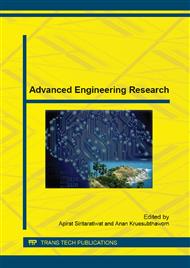p.325
p.329
p.333
p.337
p.341
p.346
p.351
p.357
p.361
Potential Evaluation of Hybrid Wind-Diesel System Island Area in Thailand
Abstract:
Some communities in Thailand located on Island with high wind velocities but an unreliable utility supply, will typically install diesel powered generators and wind generators to form a microgrid. Microgrid projects have been developed in many parts of the world, and commercial solutions have started to appear. Such systems face specific design issues, especially when the wind penetration is high enough to affect the operation of the diesel plant. The dynamic behavior of a medium penetration hybrid microgrid is investigated. It consists of a diesel generator set, a wind power generator and several loads. The diesel engine drives a 3x2,000 kW synchronous generator with excitation control. The wind turbine drives a 6x800 kW (full power converter) synchronous generator. The total load of the microgrid is about 4 MW which varies during the day. The excitation controller and speed controller for the diesel’s synchronous generator are designed, as well as the power control of the wind turbine. The system is modeled and simulated using software DIgSILENT PowerFactory. The study evaluates how the power generation is shared between the diesel generator set and the wind generator, the voltage regulation during load connections, and discusses the need of battery energy storage, the system ride-through-fault capability and frequency control. The results of several case studies are presented. The results have shown that the systems are stable under various ratio of PWIND / PLOAD from 10% to 100%, except ratio of PWIND / PLOAD from 110%.
Info:
Periodical:
Pages:
341-345
Citation:
Online since:
August 2015
Keywords:
Price:
Сopyright:
© 2015 Trans Tech Publications Ltd. All Rights Reserved
Share:
Citation:


